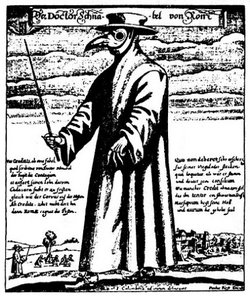
Merchants of Death
Travel, Trade, and The Bubonic Plague

http://www.themiddleages.net
It can be said that nothing controls population quite as well as a huge mass of people dying out over a short period of time. Between the years 1347 and 1352, twenty-five million Europeans died. Over just five years, one third of the population of Europe was wiped out, not by traditional weapons, but by a silent and gruesome killer: the Bubonic plague. The plague spread incredibly quickly. Doctors had no defense. The disease came to be known as the Black Death because those afflicted by it developed black spots all over their bodies as blood pooled under their skin due to mass internal bleeding. Once one person in a household began to show symptoms, an immediate forty-day quarantine was placed upon the house, all but ensuring that the entire family would die. Why were so many people dying, and dying so quickly? Why were doctors helpless against this disease? Where did it come from? And how did it get to Europe? The answers to these questions can be found by examining a single, seemingly positive aspect of society: trade.
The first outbreak of plague in Europe occurred between 541 and 544 BCE, known as Justinian’s Plague. The plague most likely traveled north along the Nile into the Mediterranean Basin. Because this was a central trading region, it quickly branched out along trading routes from Egypt into Central and South Asia, the Middle East, North Africa, and much of Southern Europe. Between 541 and 542, forty percent of Constantinople, then the central port of trade in the Mediterranean, was dead. The plague finally petered out in 544 in Northern and Central Europe due to a lack of ongoing and significant trade to and from the region. By then, however, just under twenty-five percent of the European population south of the Alps was dead as a result of Justinian’s Plague (Thomas, 1997).
From 1200 to 1350, the Mongol empire was at its height, stretching from European Russia, through the Middle East, and across China (Ponting, 1991). The success of the empire led to the opening of communications and trade routes from the steppes of central Asia into China. At the same time, floods, earthquakes, and other natural disasters were forcing plague-infected rodents out of their habitats. Like merchants carrying goods, these rodents carrying the bubonic plague, and plague-infected fleas traveled along the trade routes into China. The first outbreaks of bubonic plague in China were in the early 1330’s (Instructional Design, 2008). By the 1350’s, two-thirds of China’s population was dead (Thomas, 1997).
Meanwhile, Europe’s population had fully recovered from Justinian’s Plague and had reached record highs. Agricultural innovations allowed Europe to flourish. Three major trade routes opened up so that luxury goods from the Orient could be marketed in Europe. The first was the Silk Road, running from Northern China, through Central Asia, and then to the Black Sea. The second went from South Asia through the Persian Gulf then via caravan to the Levant. The third ran from South Asia to the Red Sea to Egypt. From the Mediterranean Basin, merchants, often Italian, picked up goods and brought them to Southern France, Italy, and through the Straits of Gibraltar to England and Holland.
It is easy to see how easy it was for an infectious disease, carried by small rodents and fleas, to spread along this network. Italian merchant ships began arriving at European ports full of dead and dying sailors. These ships were quarantined, but the quarantines served only to keep the infected sailors on the boats; there was nothing anyone could do to stop the rodents (and fleas) from scurrying down planks and ropes to the docks.
Once the disease began infecting humans in Europe, mass fatality was all but inevitable. Europeans were living close together, sanitation was more or less nonexistent, and humans were living in close proximity to animals. As the disease spread, members of the higher class – clergy, noblemen, etc. – fled, bringing the disease with them. Because the bubonic plague (and, for that matter, any strain of the plague) is not native to Europe, Europeans had no immunity against it. Once infected, the disease incubates for six days until the onset of the first symptoms. Thus, an infected person has six days in which they are unaware of their infection and are liable to have to unrestricted contact with other people. Once the fist symptoms set in, black spots on the skin, called buboes, resulting from severe hemorrhaging, the victim may become delirious and feverish. The plague kills about sixty percent of its victims.
The plague eventually died out in Russia (ironically, where it originated), most likely because the trade routes in and out of Russia were inactive. The plague had first appeared in Europe in 541. Why did Europe not feel the full force of it then? Several reasons: transportation technology did not allow for the rapid trade between China and Europe as it would in the 14 th century (Diamond, 2005). Additionally, a lower population meant that humans were not living in nearly as close quarters as they would be forced to do in the 14 th century. Trade, travel, and overpopulation were the culprits in the spread and magnitude of destruction of the Black Death.
References:
Thomas, Richard (1997, May). The TED case studies: An online journal. Retrieved March 27, 2008, from TED Case Studies: The role of trade in transmitting the Black Death Web site: http://www.american.edu/TED/bubonic.htm
Ponting, Clive. A Green History of the World. St. Martins Press, New York. 1991, Pp. 228.
Instructional Design ( 2008). The Black Death: Bubonic Plague. Retrieved March 27, 2008, from themiddleages.net Web site: http://www.themiddleages.net/plague.html
Diamond, Jared. Guns, Germs, and Steel. W.W. Norton and Company, Inc, New York. 2005. Pp. 205-207.
Send message to Swarthmore College Environmental Studies
last updated 3/27/08
webmaster